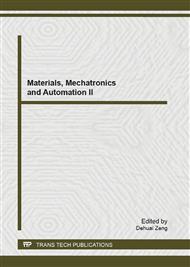[1]
J. Novak-Marcincin, J. Barna, L. Novakova-Marcincinova and V. Fecova: Analyses and Solutions on Technical and Economical Aspects of Rapid Prototyping Technology. Tehnicki Vjesnik - Technical Gazette, Vol. 18, No. 4, pp.657-661, ISSN 1330-3651, (2011).
DOI: 10.1063/1.4707641
Google Scholar
[2]
R. Pacurar, N. Balc and F. Prem: Research on how to improve the accuracy of the SLM metallic parts. In: Proceedings of the 14th International Conference on Material Forming Esaform, Queens Univ. Belfast, pp.1385-1390, (2011).
DOI: 10.1063/1.3589710
Google Scholar
[3]
T. Galeta, P. Raos and M. Somolanji: Impact of structure and building orientation on strength of 3D printed models. KGK Kautschuk Gummi Kunststoffe, Vol. 65, No. 10, pp.36-42, (2012).
Google Scholar
[4]
J. Novak-Marcincin, L. Novakova-Marcincinova, J. Barna and M. Janak: Application of FDM rapid prototyping technology in experimental gearbox development process. Tehnicki Vjesnik, Vol. 19, No. 3, pp.689-694, ISSN 1330-3651, (2012).
DOI: 10.1109/ines.2011.5954723
Google Scholar
[5]
J. Novak-Marcincin, M. Janak and L. Novakova-Marcincinova: Increasing of product quality produced by rapid prototyping technology. Manufacturing Technology, Vol. 12, No. 12, pp.71-75, ISSN 1213-2489, (2012).
DOI: 10.21062/ujep/x.2012/a/1213-2489/mt/12/1/71
Google Scholar
[6]
L. Novakova-Marcincinova and M. Janak: Application of progressive materials for RP technology. Manufacturing Technology, Vol. 12, No. 12, pp.76-79, ISSN 1213-2489, (2012).
DOI: 10.21062/ujep/x.2012/a/1213-2489/mt/12/1/75
Google Scholar
[7]
L. Novakova-Marcincinova, V. Fecova, J. Novak-Marcincin, M. Janak and J. Barna: Effective Utilization of RP Technology. Materials Science Forum, Vol. 713, pp.61-66, ISSN 1662-9752 (2012).
DOI: 10.4028/www.scientific.net/msf.713.61
Google Scholar
[8]
L. Novakova-Marcincinova, V. Fecova, J. Novak-Marcincin, M. Janak and J. Barna: Effective Utilization of Rapid Prototyping Technology. AIP Conference Proceedings, Vol. 1431, pp.834-841, ISSN 0094-243X, (2012).
DOI: 10.1063/1.4707641
Google Scholar
[9]
V. Tic and D. Lovrec: Design of modern hydraulic tank using fluid flow simulation. International Journal of Simulation Modelling, Vol. 11, No. 2, pp.77-88, ISSN 1726-4529, (2012).
DOI: 10.2507/ijsimm11(2)2.202
Google Scholar


